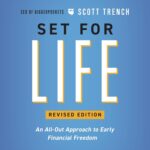Ready to level up your financial game? As a college student, you’re laying the foundation for your future. And what better way to do that than by investing in yourself? We’re talking about the Roth IRA, a powerful tool that can help you save for college, retirement, or any other major life goal.
Think of it as a financial time machine: you’re investing today to enjoy the fruits of your labor tomorrow. But with so many options out there, it can be tough to know where to start. That’s where we come in. In this guide, we’ll break down the best Roth IRAs for college students, giving you all the info you need to make an informed decision.
So, let’s dive in and discover how a Roth IRA can help you reach financial freedom!

What is a Roth IRA?
A Roth IRA is a retirement savings account that offers unique tax advantages. Unlike traditional IRAs, where you pay taxes on withdrawals, Roth IRAs allow you to pay taxes upfront on your contributions. This means that your earnings grow tax-free, and qualified withdrawals are also tax-free.
Key Features of a Roth IRA for College Students
- Tax-Free Growth and Withdrawals: The tax-free nature of Roth IRAs means you won’t have to pay income taxes on your earnings or withdrawals, potentially saving you a significant amount of money over time.
- No Required Minimum Distributions: Unlike traditional IRAs, Roth IRAs don’t have required minimum distributions. This means you can keep your money invested for as long as you want, allowing it to continue growing.
- Flexibility: Roth IRAs offer flexibility in using funds for qualified education expenses, such as tuition and fees. This can be a significant benefit for students facing rising college costs.
- Long-Term Savings: Even if you use your Roth IRA for college expenses and to curb student loan debt, it can still be a valuable tool for long-term retirement savings. The tax-free growth and withdrawals can help you build a substantial nest egg for your golden years.
Eligibility Requirements
Roth IRAs have specific eligibility rules, which can impact whether college students qualify to contribute.
- Income Limits: Roth IRA contributions are restricted based on income thresholds, which can phase out at higher income levels. For example, in 2024, single filers with a Modified Adjusted Gross Income (MAGI) below $146,000 can contribute the maximum amount, while contributions start to phase out above this threshold and are fully phased out at $161,000. These limits ensure that Roth IRAs remain a tool for lower and moderate-income earners.
- Earned Income: Roth IRAs require contributors to have earned income, which includes wages, salaries, and other forms of compensation from employment or self-employment. This means that college students need to have some form of taxable income—such as part-time job wages or freelance work—to contribute. Investment income or gifts do not count as earned income for Roth IRA contributions, making part-time work a common solution for students interested in starting a Roth IRA.
According to Bankrate, “Contributions to Roth IRAs are made with after-tax dollars, so there won’t be any tax savings immediately, but your withdrawals during retirement will be tax-free. By making contributions when you’re in college (and likely paying a low-income tax rate), you’ll avoid a larger tax bill down the road when your income will likely be taxed more. As with a traditional IRA, your investments will be allowed to compound tax-free in a Roth IRA.”

Why a Roth IRA is Great for College Students
Opening a Roth IRA as a college student provides a valuable opportunity to begin saving for retirement at an early age.
- Benefits of Compound Interest: Even small contributions can grow significantly over time due to the power of compound interest. By starting early, students can take advantage of many years of potential growth, allowing their savings to multiply without the burden of immediate taxes on earnings. The earlier they start, the more substantial their retirement nest egg can become, making it easier to achieve financial stability in the future.
- Head Start on Financial Goals: Time is one of the most crucial factors in building wealth. By contributing to a Roth IRA while in college, students can use the power of time to grow their retirement savings. This head start allows them to focus on long-term financial goals, giving them a better chance to achieve a comfortable retirement and the ability to handle future expenses.
Another appealing aspect of a Roth IRA is its flexibility regarding contributions and withdrawals.
- Withdraw Contributions Anytime: Unlike traditional retirement accounts, Roth IRAs allow account holders to withdraw their contributions at any time without penalties or taxes. This feature is particularly beneficial for college students who may need access to funds for unexpected expenses or emergencies, providing peace of mind and financial security.
- Accessing Funds for College Expenses: Students can also utilize their Roth IRA funds for qualified education expenses without incurring penalties, though earnings may be subject to taxes if withdrawn before certain conditions are met. This flexibility can help cover tuition, fees, and other educational costs, making it easier to manage finances while pursuing a degree.
- Long-Term Wealth Accumulation: The potential for tax-free growth and wealth building makes Roth IRAs an attractive option for students looking to establish a solid financial foundation.

How Roth IRA Contributions Impact Taxes
Roth IRA contributions are made with after-tax dollars, meaning they do not reduce current taxable income. However, they offer significant long-term tax benefits, particularly in retirement. Once you reach retirement age and have maintained your Roth IRA for at least five years, you can enjoy tax-free withdrawals.
This feature is especially beneficial for those who anticipate being in a higher tax bracket during retirement, as it can effectively lower their overall retirement tax burden. Students should consider their future income expectations when deciding between a Roth IRA and a traditional IRA, as the former may be more beneficial for those expecting higher earnings later. Additionally, students should evaluate the timing of converting a traditional IRA to a Roth IRA. Doing so during years of lower income can help them pay taxes at a reduced rate.

Using a Roth IRA for College Expenses
One of the significant advantages of using a Roth IRA for college expenses is the ability to withdraw funds tax-free and penalty-free for qualified higher education expenses, such as tuition and fees. This can provide a substantial financial boost to help cover the rising costs of higher education.
Understanding the Rules and Potential Penalties
While using a Roth IRA for college expenses offers many benefits, it’s essential to be aware of the withdrawal rules and potential penalties. For instance, if you withdraw funds for non-qualified expenses before reaching age 59½, you may be subject to a 10% early withdrawal penalty.
Balancing College Savings and Retirement Planning
While using a Roth IRA for college can be a strategic move, it’s crucial to prioritize retirement savings as well. Consider allocating a portion of your contributions to both college expenses and long-term retirement goals.

Roth IRA vs 529 Plans vs UGMA/UTMA accounts
When choosing a college savings strategy, it’s essential to consider the various options available. CNBC notes, “The key differences that make a Roth IRA stand out, however, include limits on who can contribute and the ability to withdraw your earnings in retirement tax-free.”
Here’s a breakdown of Roth IRAs, 529 plans, and UGMA/UTMA accounts:
Roth IRA Accounts
- Pros: Offers flexibility in using funds for qualified education expenses or retirement, tax-free growth and withdrawals, and no required minimum distributions. You won’t owe income taxes.
- Cons: Income limits on contributions, potential early withdrawal penalties if funds are used for non-qualified expenses before age 59½.
529 Plans
- Pros: Tax-deferred growth, tax-free withdrawals for qualified education expenses, and potential state tax benefits.
- Cons: Restrictions on how funds can be used, may be subject to penalties if funds are withdrawn for non-qualified expenses.
UGMA/UTMA Accounts
- Pros: Offers flexibility in using funds for any purpose, potential for gifting assets to minors.
- Cons: This may be subject to gift tax implications, child may have control over the funds upon reaching adulthood.
Choosing the Right Option
The best college savings option for you will depend on your specific circumstances. Consider the following factors:
- Income: Your income level will determine your eligibility for certain plans and may affect contribution limits.
- Financial goals: If you’re primarily focused on college savings, a 529 plan may be a good option. If you want more flexibility, a Roth IRA or UGMA/UTMA account might be better.
- State tax benefits: Some states offer tax incentives for contributing to 529 plans, which can make them more attractive.
By carefully evaluating these factors, you can select the college savings option that best aligns with your financial goals and provides the most benefits.

Opening a Roth IRA as a College Student
Here’s how to open a Roth IRA:
Choosing the Right Roth IRA
The first step is to select a provider, such as a traditional brokerage firm or an online brokerage platform. Once you’ve chosen a provider, you’ll need to decide on the type of Roth IRA account you want to open.
Funding Your Account
After opening your account, you can start contributing. Unlike traditional IRAs, Roth IRA contributions are made with after-tax dollars, reducing your taxable income. You can contribute at any time throughout the year.
Investing Your Money
Once your account is funded, you can invest your money in a variety of assets, including stocks, bonds, and mutual funds. It’s important to choose investments that align with your risk tolerance and long-term financial goals.
Seeking Professional Advice
If you’re unsure about where to start or how to invest your money, consider consulting with a financial advisor. They can help you develop a personalized investment strategy that meets your unique needs.

Managing and Growing a Roth IRA
To effectively use a Roth IRA for both college and retirement, consider the following strategies:
- Create a budget: Develop a budget with clear budget categories to help you balance short-term and long-term goals.
- Prioritize needs over wants: Focus on essential expenses to maximize your savings.
- Adjust your strategy as needed: As your life circumstances change, review and adjust your investment strategy accordingly.
- Seek professional advice: Consulting with a financial advisor can provide valuable guidance and help you make informed decisions.
- Regularly review your investments: Ensure your investment portfolio remains aligned with your goals and risk tolerance.
By following these strategies, you can effectively use a Roth IRA to build a strong financial foundation for your future and enjoy a comfortable retirement.
Common Mistakes to Avoid with a Roth IRA
To avoid common mistakes when using a Roth IRA for college savings, be mindful of the following:
- Over-contributing: Contributing more than the annual limit can result in penalties and taxes.
- Withdrawing too early: If you withdraw funds for non-qualified expenses before age 59½, you may face penalties.
- Beneficiary Designation: Ensuring an appropriate beneficiary is named.
- Income Limit Awareness: Monitoring income to stay within Roth contribution limits.
To help prevent these mistakes, keep accurate records of your contributions and withdrawals. Consider consulting with a financial advisor for guidance and to ensure you’re using your Roth IRA effectively.
Understanding Roth IRA Withdrawal Rules and Penalties
Understanding the difference between qualified and non-qualified distributions is essential for Roth IRA account holders. Qualified withdrawals are those made after reaching retirement age (59½) and having maintained the account for at least five years, allowing for tax-free access to both contributions and earnings.
In contrast, non-qualified distributions, which occur before meeting these criteria, may result in a 10% penalty on the earnings withdrawn, in addition to owing taxes on those earnings. Therefore, it is crucial for individuals to be mindful of these rules to avoid unnecessary penalties and optimize their retirement savings strategy.
Strategies to Avoid Penalties
To avoid penalties on withdrawals from a Roth IRA, individuals can employ several effective strategies. One key approach is to withdraw contributions first, as these funds can be accessed tax-free and penalty-free at any time, providing flexibility in managing financial needs. Additionally, using Roth IRA funds to cover qualified education expenses is a safe withdrawal option.
The IRS allows for penalty-free withdrawals specifically for tuition and related educational costs, enabling students to tap into their retirement savings without incurring extra charges. By understanding and utilizing these strategies, account holders can make the most of their Roth IRA while minimizing potential penalties.
Conclusion
We’ve explored the many advantages of using a Roth IRA as a college student. From tax benefits and flexibility to long-term growth potential, it’s a powerful tool to help you achieve your financial goals. The earlier you start, the more time your investments have to grow. Consistent contributions, even small ones, can make a big difference over the years.
Still unsure where to begin? Consider consulting with a financial advisor. They can help you assess your unique situation and recommend the best Roth IRA strategy to meet your specific needs.
So, what are you waiting for? Take the first step toward a brighter financial future today. Open a Roth IRA and watch your savings grow!
Frequently Asked Questions
What is a Roth IRA?
A Roth IRA is a retirement savings account that allows you to contribute after-tax dollars, meaning you pay taxes on your contributions upfront. Unlike traditional IRAs, where withdrawals are taxed as income during retirement, Roth IRA withdrawals are tax-free after reaching retirement age, provided certain conditions are met. This structure makes Roth IRAs
Can I withdraw money from my Roth IRA to pay for college expenses?
Yes, you can withdraw your contributions from a Roth IRA at any time without penalties or taxes. Additionally, the IRS allows for penalty-free withdrawals for qualified education expenses, such as tuition and fees. However, if you withdraw earnings before the age of 59½ and before the account has been open for at least five years, those earnings may be subject to taxes and a 10% penalty.
What are the eligibility requirements for contributing to a Roth IRA as a college student?
To contribute to a Roth IRA, you must have earned income, such as wages from a part-time job or self-employment income. Additionally, there are income limits for contributions; for 2024, single filers with a Modified Adjusted Gross Income (MAGI) below $146,000 can contribute the maximum amount, while contributions begin to phase out for incomes above this threshold. This ensures that Roth IRAs are primarily accessible to lower and moderate-income earners.


